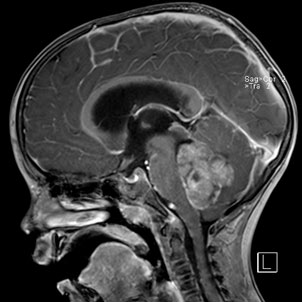Brain tumors in children
The spectrum of tumor diseases and their abundance differ significantly during childhood from those in adulthood. Thus central nervous system (CNS) tumors make up the largest category of solid tumors in children and overall with a share of approximately 25% the second most common cancer, after leukemia. Also, thelocation of the tumors and their type shows differences from those occurring in adults. Brain tumors in children are often located in the cerebellum and the brain stem (infratentorial), while the brain tumors of adults usually develop in the area of the cerebrum (supratentorial). The most common intracranial tumors in pediatric patients are astrocytoma, primitive neuroectodermal tumors (PNET including medulloblastoma) and ependymomas, but also other tumors such as craniopharyngiomas and choroid plexus papillome can be observed in this age group.

MRI image sagittal T1-weighted after contrast
agent was injected, a child with medulloblastoma
in the 4th ventricle with consecutive compression
of the cerebellum
Examples
Pilocytic astrocytoma
Pilocytic astrocytomas are generally the most common brain tumors in children. These primary brain tumors occur almost exclusively in children and young adults. They can grow both in the cerebellum and the cerebrum. Due to their benign nature the complete surgical removal gives a good chance of cure. Subsequent treatment in this case is not required. If the complete removal of the tumor is impossible, in the case of new tumor growth additionally to resection, irradiation or chemotherapy will be discussed.
Medulloblastoma
Medulloblastoma is the most common type of malignant central nervous system tumors in children. It typically originates in the posterior fossa - usually in the 4th ventricle - and grows rapidly and infiltrates the cerebellum tissue. So-called drop metastases along the cerebrospinal fluid pathways (CSF) are possible. Treatment consists ideally of the complete surgical removal, followed by adjuvant therapy consisting of chemotherapy and additionally radiotherapy in case of children older than 4 years. The treatment results show a significant improvement in recent years. This combined therapy today may permit a 5-year survival rate in 70-80% of cases.
Ependymomas
This tumor type is localized in children, especially in the 4th ventricle of the posterior fossa. Other locations are the lateral ventricles, the 3rd ventricle and the spinal canal (intraspinal). A second peak incidence is observed in adults between 30 and 40 years. These patients are usually diagnosed with intraspinal ependymomas. Ependymomas may be either benign or malignant. The therapy depends on the localization and the tumor status. However, the objective is usually a complete surgical resection. Should this succeed, usually no further treatment is necessary in case of the benign forms. If only a partial resection is possible and the tumor is malignant, post-treatment should include radiation and possibly chemotherapy.




